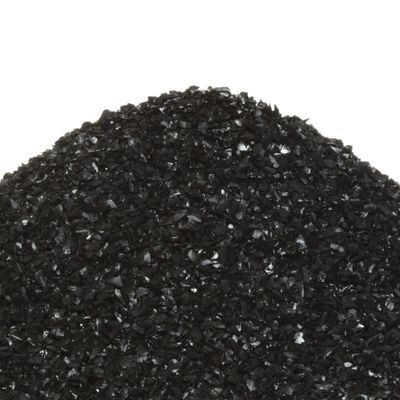
Like bone broth and kale before it, charcoal has arrived to supposedly help restore and reinvigorate your decaying, toxin-filled body. It’s the latest ingredient — yes it’s edible — to gain a foothold in the world of detoxing and purification, and it’s being used in a variety of preparations that include juice infusions, of course, as well as more gastronomically minded creations.
Unlike some other superfoods, there is some science behind the charcoal movement. It’s long been used in the health and beauty business, and in fact, ingesting charcoal is nothing new: It was used in foods like charcoal biscuits in the 1800s, and has over the years been used in hospitals to treat patients with food poisoning. The thinking behind its healing powers is that it’s adsorbent, which means that other molecules and substances — like harmful poisons from inedible berries — adhere to it. In the medical world, it’s used to offset the effects of drug overdoses. Activated charcoal — the kind you’ve likely seen — has been treated in a way that, according to at least some medical professionals, “makes it ideal for removing potentially toxic substances from the digestive tract.”
Those findings, in turn, have led its proponents in the wellness community to play up charcoal’s ability to adsorb all sorts of things, helping expunge the body of the ever-popular toxins, poisons, and viral infections, even lowering cholesterol. People claim that activated charcoal will aid your liver, colon, digestive tract, heart, and brain. In other words, charcoal just makes your body function better.
The actual medical community doesn’t necessarily back these claims, but the idea nevertheless plays nicely into the public’s increased desire for food that keeps our bodies pure in some way (witness, for example, the increased awareness and appreciation for vegan cuisine, even by meat-eaters). Los Angeles shop Juice Served Here debuted a Charcoal Lemonade a couple years back, to much acclaim, and New York chain Juice Generation followed soon after with its own line of charcoal-laden drinks. There are also products like the coconut-charcoal capsules from Bulletproof, the company that’s best known for spiking coffee with butter to make it healthier. Juice Generation’s chief executive Eric Helms has said that activated charcoal improves organ function and cures bad breath; the owner of green-juice company LuliTonix, which sells an activated charcoal elixir, told Vogue that she always brings it on airplanes because it helps her combat jet lag. Some see claims like this as dubious at best, but Juice Generation’s charcoal drinks quickly became the company’s best-selling items, suggesting that customers are willing to believe — and pay for — any potential benefits.
Now, the use of charcoal has moved beyond the usual wellness suspects into culinary applications: Alissa Wagner, one of the owners of the California-ish Lower East Side restaurant Dimes, has been toying with ways to incorporate charcoal into her menu, possibly in a smoothie or a cracker. At Lowlife, which recently opened on Stanton Street with a Blanca veteran running the kitchen, a dish of fluke and caviar gets a spritz of charcoal-infused oil.
The problem for chefs, it seems, is that charcoal might be an appealing-sounding ingredient, but it isn’t always the easiest — or most delicious — ingredient to use. “I haven’t loved it yet — when there’s enough in there for the health benefits, it’s gotten this chalky flavor,” says Nicholas Morgenstern, who is working on incorporating the ingredient into a raw-date-and-charcoal bar at his sunny café El Rey. He also added charcoal to a black-licorice ice cream at Morgenstern’s Finest Ice Cream this past summer with a recipe that employed fine charcoal powder imported from Japan. “In theory, it can be taken in small doses, but it depends on the source,” Morgenstern explains. “Like, there’s good fish oil and shitty fish oil. The stuff we were getting, they were saying it was culinary-grade.” Even amid these projects, Morgenstern concedes that food isn’t the simplest application: “It’s definitely easier to incorporate into beverages because you can just dump it in there.”
Pharmacist Stanley George, who runs the appealingly retro Stanley’s Pharmacy on Ludlow Street (think: part drug store, part throwback soda fountain), says he’s been selling charcoal capsules for more than a decade and now offers charcoal-laced drinks with specific medicinal purposes, including one called the Black Wave, which he says will help people who are suffering from food poisoning. George, though, says people need to be careful with charcoal. “I noticed about two years ago, as people were getting deeper and deeper into the whole detox-juicing culture and it was blowing up as a fad, everybody was always looking for the next thing,” he says. “Suddenly, somebody, or a group of people, caught on to charcoal. I don’t know who the first person is who hailed it in the juicing culture, but I think once that caught on as the way to adsorb toxins and detox — what are you detoxing from?”
So, while charcoal can potentially help with some issues, it’s definitely not some black-magic elixir that is going to purge your body of everything bad. Treating it as a superfood undermines whatever benefits charcoal may actually have, and incorporating it into juices probably won’t give you any actual health boost. Critics also say in no uncertain terms that the very idea of “detoxing” as most people understand it has no connection with its effectiveness in a medical setting:
What’s popularly called a “detox” today has nothing to do with actual medical detoxification. In the setting of real medicine, detoxification means treatments for dangerous levels of drugs, alcohol, or poisons, like heavy metals. Real detoxification is a treatment for a medical emergency, when a poisoning may be life-threatening. Real detoxification isn’t something you contemplate based on a menu. You don’t order real detoxification treatments at a juice bar, and it’s not delivered in smoothie format.
Fake detox, the kind you find in magazines, and sold in pharmacies, juice bars, and health food stores, is make-believe medicine. The use of the term “toxin” in this context is meaningless. There are no toxins named, because there’s no evidence that these treatments do anything at all, but it sounds just scientific enough to be plausible.
Even some people who employ charcoal will happily point out that it all feels a little snake-oil-y: At Mission Chinese Food in New York, beverage director Sam Anderson uses activated charcoal in a pitch-black drink called the Moonwalk, which also includes mezcal, sake, yuzu kosho, and a garnish of bee pollen rolled in edible golden glitter. Anderson says the inclusion of charcoal has nothing to do with any supposed health benefits. He just wanted to make a cocktail that looks cool. Guests have responded, and Anderson says it’s the best seller on the new cocktail list: “Yeah, there are medical claims, but it won’t be something I purport,” Anderson says. “I highly doubt it’s true you won’t have a hangover. I’m using it for theatrical purposes.”





